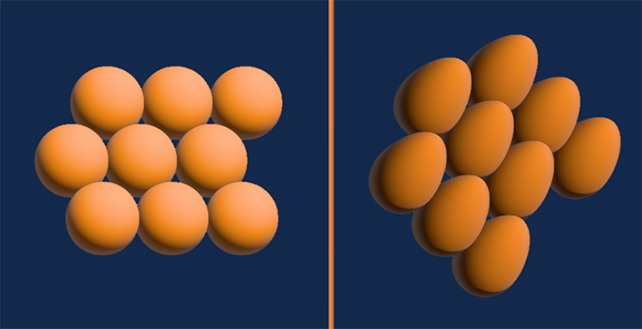Products You May Like
By teaching a machine to learn a few quantum tricks, physicists have uncovered a strange new phase of hydrogen in solid form. While it’s purely theoretical for now, the discovery could help us better understand the behavior of matter from the tiniest scales to the internal mechanics of the largest planets in the Universe.
This new solid hydrogen phase discovered by an international team of researchers followed the model’s presentation of hydrogen molecules under extreme conditions: to use a food analogy, their shape morphed from spheres stacked like a pile of oranges to something that more closely resembled eggs.
Hydrogen typically requires very low temperatures and very high pressures to form a solid. It was through a novel machine learning study of this particular phase change that the scientists came across the new molecular arrangement.

“We started with the not-too-ambitious goal of refining the theory of something we know about,” says physicist Scott Jensen from the University of Illinois Urbana-Champaign.
“Unfortunately, or perhaps fortunately, it was more interesting than that. There was this new behavior showing up. In fact, it was the dominant behavior at high temperatures and pressures, something there was no hint of in older theory.”
An updated machine learning algorithm played a significant part in the research: it was able to model the actions of thousands of atoms rather than the hundreds so many studies of quantum phenomena are limited to.
The researchers used an improved version of what’s known as the Quantum Monte Carlo (QMC) technique: essentially, it uses random sampling and probability math to work out how large groups of atoms are behaving en masse, groups that would be too difficult to study in an actual experiment.
A second computational method – one better able to handle more atoms but without the accuracy – was then used to verify the results. As the findings matched, it suggests the enhanced QMC technique is working as intended.
“Machine learning turned out to teach us a great deal,” says physicist David Ceperley, from the University of Illinois Urbana-Champaign. “We had been seeing signs of new behavior in our previous simulations, but we didn’t trust them because we could only accommodate small numbers of atoms.”
“With our machine learning model, we could take full advantage of the most accurate methods and see what’s really going on.”
Simply put, the machine learning component improved the accuracy and scope of the simulations the scientists could run, using existing data and previous simulations to make future ones more precise in terms of their estimates.
Not only is hydrogen the most abundant element in the Universe, but it’s also the simplest in terms of its individual atoms: one proton and one electron. That means new discoveries about hydrogen can affect almost everything else in physics.
For now, it’s too early to know what this new phase of solid hydrogen means, and more experimentation and simulation are required to look at it more closely. However, the study of hydrogen-filled planets like Jupiter and Saturn is just one area where this extra understanding can be useful.
“We want to understand everything, so we should start with systems that we can attack,” says Ceperley. “Hydrogen is simple, so it’s worth knowing that we can deal with it.”
The research has been published in Physical Review Letters.
